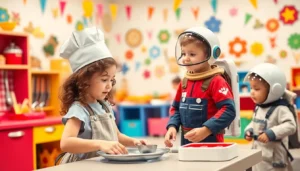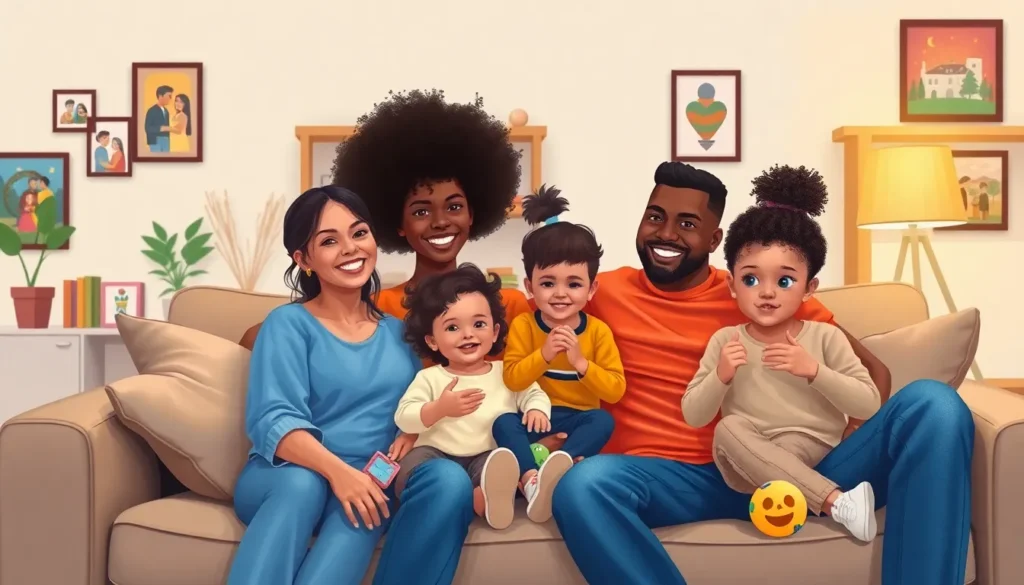Table of Contents
ToggleFostering and adoption aren’t just about giving kids a home; they’re about creating families in the most unexpected ways. Imagine transforming a spare room into a cozy haven or turning a grocery run into a heartwarming adventure. Every child deserves a loving environment, and fostering or adopting can be the key to unlocking their potential.
While the process can feel like navigating a maze blindfolded, the rewards are priceless. It’s not just about changing a child’s life; it’s about the joy, laughter, and sometimes chaos that comes with welcoming new faces into your world. So, if you’ve ever thought about expanding your family tree, buckle up! The journey of fostering and adoption is filled with surprises, love, and maybe a few hilarious moments along the way. Let’s dive into what it really means to open your heart and home.
Understanding Fostering And Adoption
Fostering and adoption offer unique pathways to create loving families. Each process plays a vital role in providing support and stability for children in need.
What Is Fostering?
Fostering involves temporarily caring for a child until a permanent solution is found. Agencies typically arrange this process, matching children with foster families. These families provide a safe environment, addressing the emotional and physical needs of children. While fostering may last a few days to several years, the goal focuses on reunification with biological families whenever possible. Support systems for foster parents include training and resources to navigate challenges. Foster care not only enriches children’s lives but also allows families to experience the joys of nurturing a child.
What Is Adoption?
Adoption is a legal process that creates a permanent family relationship between a child and adoptive parents. The journey often involves extensive background checks and home studies to ensure a safe, nurturing environment. Adoption can occur through various means, such as domestic agencies, international agencies, or foster care systems. Once finalized, adoptive parents gain all the rights and responsibilities of biological parents. This process offers children stability and a lifelong family connection. Many families celebrate adoption as a transformative moment, embracing the commitment and love it entails.
The Fostering Process

The fostering process involves multiple steps to ensure a child finds a safe and nurturing environment. Understanding these steps aids potential foster parents in making informed decisions.
Steps Involved In Fostering
- Information Sessions: Attend informational meetings offered by local child welfare agencies.
- Application Submission: Complete a detailed application form, outlining personal information and motivations for fostering.
- Background Checks: Undergo thorough background checks for safety assurance.
- Home Study: Participate in a home study assessment, which evaluates the living environment and family dynamics.
- Training: Complete mandated training sessions covering caregiving skills, trauma-informed care, and child behavior management.
- Placement: After approval, match with a child needing placement and welcome them into the home.
Requirements For Foster Parents
Foster parents must meet specific criteria to provide effective care. They must be at least 21 years old, offering a secure living environment. A stable income and sufficient space in the home are necessary for accommodating children.
Support networks also play a crucial role. Foster parents should maintain a supportive relationship with family and friends. Finally, commitment to foster children’s needs is essential to ensure their emotional and physical security throughout their stay.
The Adoption Process
The adoption process involves several key components that vary based on circumstances and legal requirements. Understanding these aspects helps families prepare for their journey.
Types Of Adoption
Adoption can occur through various avenues. Domestic adoption involves adopting a child from within the same country. International adoption connects families with children from different countries. Foster to adopt embraces children in the foster care system, where the goal may shift to permanency. Stepparent adoption occurs when a spouse adopts their partner’s biological child, solidifying family bonds. Each type presents unique challenges and regulations, necessitating thorough research and preparation before proceeding.
Steps To Adopt A Child
Adopting a child requires following specific steps to ensure the process is smooth. Initially, prospective parents must attend informational sessions to gain insight into the adoption landscape. Afterward, they submit an application to express their intent. Background checks follow, assessing the suitability of the home environment. A home study occurs next, involving in-depth evaluations of the household dynamics. Completing prospective parent training equips individuals with necessary skills. Finally, welcoming a child into the family brings joy and fulfillment, marking the culmination of a thoughtful process.
Benefits Of Fostering And Adoption
Fostering and adoption create substantial benefits for both children and families. Understanding these advantages highlights the positive impact these processes have on lives.
Impact On Children
Fostered and adopted children often experience emotional healing in nurturing environments. Access to stability helps them develop important life skills. With consistent care and guidance, children increase their self-esteem and confidence. Relationships formed within loving families promote their social development. Many children thrive academically, benefiting from supportive home environments. Providing security fosters resilience and optimism for their futures. Each positive interaction contributes to their overall well-being.
Impact On Families
Families experience profound joy and fulfillment from fostering and adopting. Strengthened bonds emerge as family members learn to navigate challenges together. Each shared experience promotes unity, creating lasting memories. Caregivers gain insight into parenting and personal growth through diverse experiences. Many families report increased happiness and purpose in their lives. Embracing new family members enriches the lives of all involved. The shared commitment to a child’s development builds a sense of community and connection. Fostering and adoption create families rooted in love and support.
Challenges Faced In Fostering And Adoption
Fostering and adoption involve various challenges that families encounter throughout the journey. Recognizing these obstacles proves essential for successful outcomes.
Emotional Challenges
Emotional turbulence often affects foster and adoptive families. Children may struggle with attachment issues due to prior trauma or instability. Attachment styles can manifest differently, creating tension in relationships. Foster parents experience feelings of anxiety, helplessness, or uncertainty about the child’s future. Parents navigate complex emotions as children adapt to new environments, sometimes displaying behavioral issues. Support from trained professionals can help manage these emotional challenges effectively. Seeking communities and support networks fosters resilience and understanding among families.
Legal Challenges
Legal complexities frequently arise during fostering and adoption. Navigating child welfare laws requires thorough knowledge of the specific regulations governing the process. Background checks, home studies, and documentation play crucial roles in ensuring suitability for child placement. Legal requirements can vary significantly by jurisdiction, leading to confusion. Timelines for the approval process might extend, creating additional frustration. Having access to experienced legal assistance helps mitigate these challenges, ensuring compliance with necessary laws. Familiarity with legal obligations empowers families to advocate effectively for the children in their care.
Fostering and adoption are powerful journeys that create lasting bonds and transform lives. They offer children the chance to heal and thrive in loving environments while providing families with unparalleled joy and fulfillment. Navigating the complexities of these processes requires dedication and support but the rewards far outweigh the challenges.
By embracing the roles of foster and adoptive parents, individuals contribute to a child’s future and create a nurturing atmosphere that fosters growth and stability. The commitment to providing a safe and loving home not only enriches the lives of children but also strengthens family connections, fostering a sense of community and shared purpose. Each step taken in this journey is a step toward a brighter future for both the child and the family.










